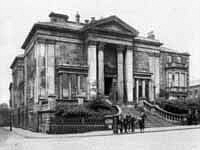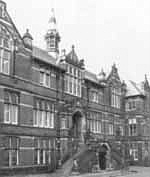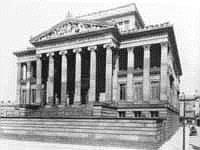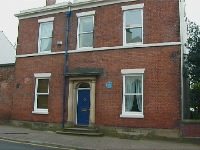The Institution for the Diffusion of Useful Knowledge was founded by the Temperance Movement in 1828 and was originally located in Cannon Street. The Institute was a competitor of in Winckley Square.
 |
A classical-revivalist building, the Institute has a three-bay facade, the pediment above the entrance being supported by pilasters and a pair of fluted Corinthian columns. This photgraph dates from the early 1900s. |
The foundation stone was laid in 1844 and the building was constructed between 1846 and 1849 from the designs of John Welch, a local architect. ”The Avenham Institute”, or as it was popularly known, “The Mechanics Institute” moved into the building at the end of Avenham Walk in 1850. In 1882 the trustees of the late Edmund Robert Harris, a local solicitor who had died in 1877, endowed the Institution. A number of houses in Regent Street were purchased and demolished so that the Institute could be extended. The Institute, henceforth to be known as the Harris Institute became a centre of excellence for the teaching of Art and Science.
In the early Edwardian period it was in financial danger owing to a decrease in the number of students, overstaffing and what was referred to as “lack of mental equipment in those presenting themselves for examination” (!).
The trustees later paid for the Harris Technical College in Corporation Street, to celebrate Queen Victoria’s Jubilee. The building was opened by the Earl of Derby in 1899 to provide the young people of the area with a technical education. It was well equipped with modern machinery for spinning and weaving cotton, "all of which was driven by electricity". Other studies included mechanics and engineering; machine and building construction; carpentry and joinery; plumbing; masonry and brickwork and electrical engineering.
 |
The Harris Institute in Corporation Street. The original building was symmetrical with a Tudor-style facade. It was substantially extended in 1931. |
In 1932 the Harris Institute became the Harris Art College. The Harris Institute expanded continuously and in 1952 became the Harris College. In 1970 this was elevated into Preston (later Lancashire) Polytechnic. The culmination of this upward progress was its incorporation in 1992 as the University of Central Lancashire. Today the building is part of the University that owes its very existence to “The Avenham Institute” and the Harris Trustees.
The “Bequest of Edmund Robert Harris” still benefits the people of Preston today. The endowment funds are controlled, as in the past, by 12 Trustees. There are two funds, one attached to the “Harris Free Library, Museum and Art Gallery” and the other to ”The Harris Orphanage” which is now part of the University’s “Knowledge Park”.
The Harris Free Library, Museum and Art Gallery was designed by a local architect, Alderman James Hibbert. The foundation stone was laid, with Masonic Ceremonial by the Earl of Latham, during the guild celebrations of 1882. A ceremonial opening took place, by Lord Derby, in October 1893. No part of the building was open to the public until the 1st January 1894 when the Lending Library, Newsroom and Reading Room opened. The Reference Library, Picture and Sculpture galleries opened on the 1st January 1896.
 |
The Harris Free Library, Museum and Art Gallery, one of the finest Greek Revival buildings in Britain. It rests on an elevated base of rusticated stone. The frontage is dominated by a row of six Ionic columns, fluted and carrying a pediment with sculptures. This photograph was taken in 1894. |
 |
Edmund Robert Harris and his father, The Reverend Robert Harris, Vicar of St George’s Church, all lived at 13 Ribblesdale Place. There is a plaque there now to commemorate that fact. |